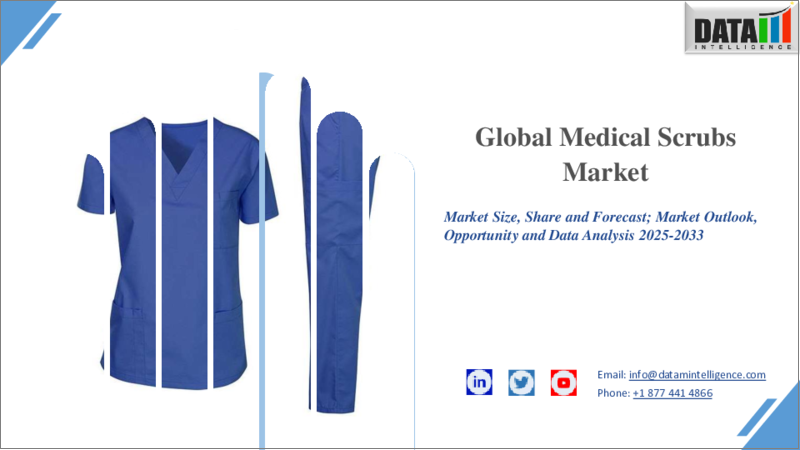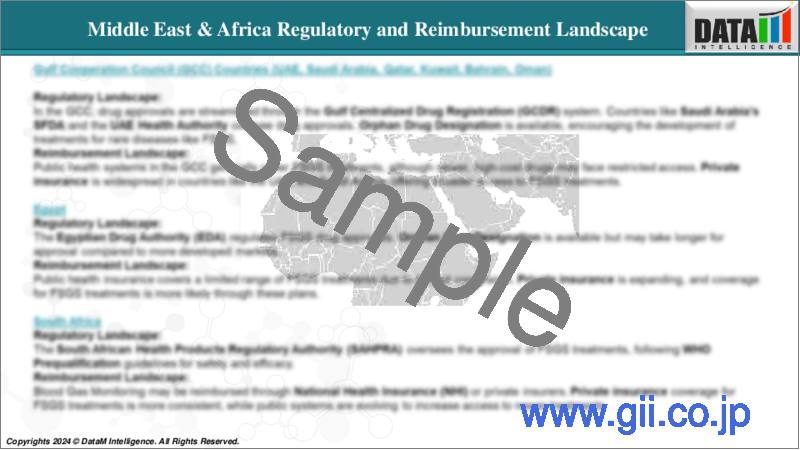|
|
市場調査レポート
商品コード
1336765
医療用スクラブの世界市場-2023年~2030年Global Medical Scrubs Market - 2023-2030 |
||||||
カスタマイズ可能
適宜更新あり
|
|||||||
| 医療用スクラブの世界市場-2023年~2030年 |
|
出版日: 2023年08月22日
発行: DataM Intelligence
ページ情報: 英文 195 Pages
納期: 即日から翌営業日
|
- 全表示
- 概要
- 目次
概要
医療用スクラブの世界市場は、2022年に865億米ドルに達し、2023~2030年の予測期間中にCAGR 5.8%で成長し、2030年には1,344億米ドルに達すると予測されています。
医療用スクラブは(スタッフの住居ではなく)専門施設で処理されるため、潜在的に危険な病気やウイルスの感染を抑えることができます。スクラブは、他の医療用リネンと同様に、正確かつ衛生的に洗濯する必要があります。医師用の医療用スクラブは、有害な汚染物質や蒸気を検出するのに非常に役立ちます。糞便、尿、血液、嘔吐物、その他の物質や液体が含まれている可能性があります。汚染や雑菌の蔓延を防ぐためには、このような対策が不可欠です。
さらに、世界の医療用スクラブ市場は、新素材の発売の増加、医療産業の上昇、医療関連感染に対する認識、これらの国における医療資源と医療従事者の急速な拡大、医療従事者の急速な増加など、さまざまな要因によって牽引され、予測期間中に市場を促進するのに役立ちます。
ダイナミクス
医療専門家の増加
医療従事者の増加は制服や作業着の需要を押し上げるため、医療用スクラブ市場に直接的な影響を与えます。医療部門が拡大し、より多くの専門家がこの分野に参入するにつれて、適切なアパレル、特に医療用スクラブの需要が拡大しています。
例えば、インド保健・家族福祉省が2022年に発表した報告書によると、西洋医学の医師が80%、AYUSH(インド伝統医学)の医師が56万5,000人と仮定すると、医師人口比は1:834となります。また、国内には28万9,000人の登録歯科医、326万3,000人の登録看護師、130万人の関連医療専門家がいます。このため、これらの国の医療従事者からの医療用スクラブ市場の需要が増加すると予想されます。
ファッショナブルな製品に対する需要の高まり
魅力的なスクラブに対する需要の高まりにより、カスタマイズやパーソナライゼーションが重視されるようになっています。メーカーによっては、名前、ロゴ、特徴的なデザインなどを個人向けにカスタマイズできるものもあり、医療従事者が自分だけのユニフォームを作れるようになっています。このような要因が、予測期間中の市場成長を後押ししています。
2023年2月、FableticsはFabletics Scrubsの発売を発表しました。Fabletics Scrubsは世界初のアクティブウェア・スクラブであり、同ブランドのプレミアム品質、デザイン、パフォーマンスウェアの専門知識を医療アパレルカテゴリーにもたらすものです。6,500人以上の医療従事者からの広範な調査と洞察によって開発されたFabletics Scrubsは、従来のスクラブユニフォームを再定義し、耐久性があり、快適で、非常に活動的なコミュニティが一日中着用するために作られたパフォーマンスグレードのワークウェアコレクションを作りました。
診療報酬の不足
院内感染(HAI)予防のために病院全体で医療用スクラブの採用が大幅に増加したことが、コスト上昇の主な原因となっています。米国、カナダ、英国、オーストラリア、ドイツ、フランスなど多くの国々では、これらの製品に対して償還が行われています。例えば、Happythreads LTD.が発表した記事によると、2022年5月、アイルランドでは、看護師は最大1,264米ドル、医師は4年間で1,199米ドル(1,112ユーロ)のユニフォームの税還付を請求できます。
しかし、中国、インド、ブラジル、インドネシア、アフリカなどの新興国では、医療従事者の購入に対する補償がないため、これらのルールは依然として不十分で、自己負担の増加に拍車をかけています。その結果、これらの国々では、着用スクラブや医療用アパレルの需要が増加しています。
目次
第1章 調査手法と調査範囲
第2章 定義と概要
第3章 エグゼクティブサマリー
第4章 市場力学
- 影響要因
- 促進要因
- 医療専門家の増加
- ファッショナブルな製品に対する需要の高まり
- 抑制要因
- 償還の欠如
- 機会
- 相変化材料の使用
- 影響分析
- 促進要因
第5章 産業分析
- ポーターのファイブフォース分析
- サプライチェーン分析
- 価格分析
- 規制分析
第6章 COVID-19分析
第7章 製品別
- 手術用スクラブ
- 看護用スクラブ
- 妊婦・患者用スクラブ
- 白衣
第8章 素材別
- 綿
- ポリエステル
- レーヨン
- スパンデックス
第9章 用途別
- 再利用可能
- 使い捨て
第10章 エンドユーザー別
- 病院
- 専門クリニック
- 外来手術センター
- 調査・診断検査室
- その他
第11章 地域別
- 北米
- 米国
- カナダ
- メキシコ
- 欧州
- ドイツ
- 英国
- フランス
- スペイン
- イタリア
- その他欧州
- 南米
- ブラジル
- アルゼンチン
- その他南米
- アジア太平洋
- 中国
- インド
- 日本
- その他アジア太平洋
- 中東・アフリカ
第12章 競合情勢
- 競合シナリオ
- 市況/シェア分析
- M&A分析
第13章 企業プロファイル
- Cardinal Health
- 会社概要
- 製品ポートフォリオと説明
- 財務概要
- 主な動向
- Halyard Heallth
- Barco Uniforms
- Superior Uniform Groups
- Medline Industries
- Mölnlycke Health Care
- Dickies Medical
- Narang Medical Limited
- Landau
- ABG Uniforms
第14章 付録
Overview
Global Medical Scrubs Market reached US$ 86.5 billion in 2022 and is expected to reach US$ 134.4 billion by 2030 growing with a CAGR of 5.8% during the forecast period 2023-2030.
Medical scrubs that are treated in a specialised facility (rather than in staff residences) help to limit the transmission of potentially dangerous illnesses and viruses. Scrubs must be washed with the same accuracy and attention to hygiene as any other medical care linen. Medical scrubs for doctors are quite useful in detecting harmful pollutants and vapours. They may contain faeces, pee, blood, vomit, and other substances or fluids. It is critical to do so in order to reduce contamination and the spread of germs.
Furthermore, the global medical scrubs market is driven by various factors like an increase in new material launches, a rise in the healthcare industry, awareness of healthcare-associated Infections rapid expansion of the healthcare resources and personnel in these countries, rapid increase in the number of healthcare professionals and among others helps to drive the market during the forecast.
Dynamics
Rise in The Number of Healthcare Professionals
The rising number of healthcare professionals has a direct influence on the medical scrubs market, as it drives up demand for uniforms and work clothing. As the healthcare sector expands and more experts enter the area, correspondingly rises the demand for proper apparel, especially medical scrubs.
For instance, according to a report published by the Ministry of Health and Family Welfare 2022. The doctor-population ratio is 1:834 in the country assuming 80% availability of registered allopathic doctors and 5.65 lakh AYUSH doctors. Also, there are 2.89 lakh registered dentists, 32.63 lakh registered nursing personnel and 13 lakh Allied and Healthcare Professionals in the country. This is anticipated to lead to increasing demand for the medical scrubs market from the healthcare workforce in these countries.
Rise in Demand For Fashionable Products
The rising demand for attractive scrubs has resulted in a greater emphasis on customisation and personalisation. Some manufacturers include personalised alternatives for names, logos, or distinctive designs, allowing healthcare practitioners to create personalised uniforms. Thus this factor indeed helps to drive the market growth during the forecast period.
In February 2023, Fabletics announced the launch of Fabletics Scrubs, the world's first-of-its-kind activewear scrubs that brings the brand's expertise in premium quality, design and performance wear to the medical apparel category. Developed through extensive research and insights from over 6,500 medical professionals, Fabletics Scrubs has redefined the traditional scrubs uniform to create a collection of performance-grade workwear that is durable, comfortable and made for daylong wear by a highly active community.
Lack of Reimbursement
The significant increase in the adoption of medical scrubs across hospitals to prevent hospital-acquired infections (HAIs) has majorly contributed to its increased cost. Many countries such as the U.S., Canada, the U.K., Australia, Germany, and France offer reimbursement for these products. For instance, according to an article published by Happythreads LTD., in May 2022, in Ireland, nurses can claim up to USD 1,264, and doctors can claim USD 1,199 (€1,112) tax back on uniforms over four years.
These rules, however, continue to be lacking for emerging countries such as China, India, Brazil, Indonesia, and Africa because there is no compensation for healthcare employees' purchases, which adds to an increase in out-of-pocket spending. This has resulted in an increase in demand for worn scrubs and medical apparel in these nations.
Segment Analysis
The global medical scrubs market is segmented based on product, material, usage, end user and region.
The Surgical Scrubs From the Product Segment Accounted for Approximately 43.7% of the Medical Scrubs Share
The surgical scrubs from the product segment with around 43.7% is expected to dominate during the forecast period, owing to due to increasing focus on preventive care amongst healthcare professionals. The growing number of surgical procedures and rapidly developing healthcare infrastructure are the key factors propelling medical uniforms, primarily contributing to the segment's growth.
For instance, according to an article published by The Network Association of Uniform Manufacturers and Distributors (NAUMD) in October 2022, Ouragins, a medical apparel company, emphasizes reinventing the medical scrub fabric with its ThreadFusion technology. ThreadFusion antimicrobial technology aids in the infusion of copper in the medical scrubs fabric and kills 99% of the germs within 2 hours after contact with the scrub surface.
Geographical Penetration
North America Accounted for Approximately 38.4% of the Market Share in 2022
North America is estimated to hold about 38.4% of the total market share throughout the forecast period, due to the many key players' focus on launching new products with unique designs, contributing to the market growth in the region.
For instance, in November 2021, Livinguard, a Swiss-based company, launched an apparel line of permanent self-disinfecting scrubs, under scrubs, and lab coats using EPA-registered textiles. These scrubs continuously self-disinfect throughout the day, providing hygienic performance for healthcare workers. The technology is tested for hypoallergenic skin sensitivities and is wash-durable for long-lasting performance.
Competitive Landscape
The major global players in the medical scrubs market include Cardinal Health, Halyard Health, Barco Uniforms, Superior Uniform Groups, Medline Industries, Mölnlycke Health Care, Dickies Medical, Narang Medical Limited, Landau, ABG Uniforms and among others.
COVID-19 Impact Analysis
The COVID-19 epidemic had a severe influence on the medical scrubs market. The epidemic disrupted global supply chains and reduced demand for goods and services in a variety of industries, including the medical scrubs market. One of the most significant effects of COVID-19 on the medical scrubs market was a decrease in consumer expenditure, especially in the first half of 2020. Consumers were hesitant to make non-essential purchases as several countries implemented lockdowns and social distancing measures, affecting market demand.
Russia Ukraine Conflict Analysis
The Russia-Ukraine conflict is estimated to have a moderate impact on the global medical scrubs market, owing to the low prevalence and absence of key market players in this region. However, the impact of the import and export of fabric materials is expected to have little influence over the global medical scrubs market growth over the forecast period.
By Product
- Surgical Scrubs
- Nursing Scrubs
- Maternity and Patient Scrubs
- Lab Coats
By Material
- Cotton
- Polyester
- Rayon
- Spandex
By Usage
- Reusable
- Disposable
By End User
- Hospitals
- Speciality Clinics
- Ambulatory Surgical Centres
- Research and Diagnostic Laboratories
- Others
By Region
- North America
- U.S.
- Canada
- Mexico
- Europe
- Germany
- U.K.
- France
- Spain
- Italy
- Rest of Europe
- South America
- Brazil
- Argentina
- Rest of South America
- Asia-Pacific
- China
- India
- Japan
- Australia
- Rest of Asia-Pacific
- Middle East and Africa
Key Developments
- In February 2023, Taara launched sustainable medical scrubs designed to meet the needs of healthcare professionals. The scrub line features Bluesign-approved fabric made from recycled material that matches the criteria of OEKO-TEX standards and comes in a variety of styles, colours, and sizes.
- In May 2022, Rebecca Lau Marsh, a fashion stylist, collaborated with medical professionals for the launch of 21 Scrubs, which is an Australian company featuring fashionable medical scrubs.
- In July 2020, Uniform Advantage, a top medical apparel brand, developed and launched its new and innovative medical scrubs collection, "Movement by Butter-Soft." These new arrivals check all boxes when it comes to functionality, comfort, and style.
Why Purchase the Report?
- To visualize the global medical scrubs market segmentation based on product, material, usage, end user and region as well as understand key commercial assets and players.
- Identify commercial opportunities by analyzing trends and co-development.
- Excel data sheet with numerous data points of medical scrubs market level with all segments.
- PDF report consists of a comprehensive analysis after exhaustive qualitative interviews and an in-depth study.
- Product mapping available as excel consisting of key products of all the major players.
The global medical scrubs report market would provide approximately 53 tables, 54 figures and 195 pages.
Target Audience 2023
- Manufacturers/ Buyers
- Industry Investors/Investment Bankers
- Research Professionals
- Emerging Companies
Table of Contents
1. Methodology and Scope
- 1.1. Research Methodology
- 1.2. Research Objective and Scope of the Report
2. Definition and Overview
3. Executive Summary
- 3.1. Snippet By Product
- 3.2. Snippet by Material
- 3.3. Snippet by Usage
- 3.4. Snippet by End User
- 3.5. Snippet by Region
4. Dynamics
- 4.1. Impacting Factors
- 4.1.1. Drivers
- 4.1.1.1. Rise in The Number of Healthcare Professionals
- 4.1.1.2. Rise in Demand For Fashionable Products
- 4.1.2. Restraints
- 4.1.3. Lack of Reimbursement
- 4.1.4. Opportunity
- 4.1.4.1. Use of Phase Change Materials
- 4.1.5. Impact Analysis
- 4.1.1. Drivers
5. Industry Analysis
- 5.1. Porter's 5 Forces Analysis
- 5.2. Supply Chain Analysis
- 5.3. Pricing Analysis
- 5.4. Regulatory Analysis
6. COVID-19 Analysis
- 6.1. Analysis of COVID-19
- 6.1.1. Scenario Before COVID-19
- 6.1.2. Scenario During COVID-19
- 6.1.3. Scenario Post Covid-19
- 6.2. Pricing Dynamics Amid COVID-19
- 6.3. Demand-Supply Spectrum
- 6.4. Government Initiatives Related to the Market During Pandemic
- 6.5. Manufacturers Strategic Initiatives
- 6.6. Conclusion
7. By Product
- 7.1. Introduction
- 7.1.1. Market Size Analysis and Y-o-Y Growth Analysis (%), By Product
- 7.1.2. Market Attractiveness Index, By Product
- 7.2. Surgical Scrubs *
- 7.2.1. Introduction
- 7.2.2. Market Size Analysis and Y-o-Y Growth Analysis (%)
- 7.3. Nursing Scrubs
- 7.4. Maternity and Patient Scrubs
- 7.5. Lab Coats
8. By Material
- 8.1. Introduction
- 8.1.1. Market Size Analysis and Y-o-Y Growth Analysis (%), By Material
- 8.1.2. Market Attractiveness Index, By Material
- 8.2. Cotton *
- 8.2.1. Introduction
- 8.2.2. Market Size Analysis and Y-o-Y Growth Analysis (%)
- 8.3. Polyester
- 8.4. Rayon
- 8.5. Spandex
9. By Usage
- 9.1. Introduction
- 9.1.1. Market Size Analysis and Y-o-Y Growth Analysis (%), By Usage
- 9.1.2. Market Attractiveness Index, By Usage
- 9.2. Reusable*
- 9.2.1. Introduction
- 9.2.2. Market Size Analysis and Y-o-Y Growth Analysis (%)
- 9.3. Disposable
10. By End User
- 10.1. Introduction
- 10.1.1. Market Size Analysis and Y-o-Y Growth Analysis (%), By End User
- 10.1.2. Market Attractiveness Index, By End User
- 10.2. Hospitals *
- 10.2.1. Introduction
- 10.2.2. Market Size Analysis and Y-o-Y Growth Analysis (%)
- 10.3. Speciality Clinics
- 10.4. Ambulatory Surgical Centres
- 10.5. Research and Diagnostic Laboratories
- 10.6. Others
11. By Region
- 11.1. Introduction
- 11.1.1. Market Size Analysis and Y-o-Y Growth Analysis (%), By Region
- 11.1.2. Market Attractiveness Index, By Region
- 11.2. North America
- 11.2.1. Introduction
- 11.2.2. Key Region-Specific Dynamics
- 11.2.3. Market Size Analysis and Y-o-Y Growth Analysis (%), By Product
- 11.2.4. Market Size Analysis and Y-o-Y Growth Analysis (%), By Material
- 11.2.5. Market Size Analysis and Y-o-Y Growth Analysis (%), By Usage
- 11.2.6. Market Size Analysis and Y-o-Y Growth Analysis (%), By End User
- 11.2.7. Market Size Analysis and Y-o-Y Growth Analysis (%), By Country
- 11.2.7.1. U.S.
- 11.2.7.2. Canada
- 11.2.7.3. Mexico
- 11.3. Europe
- 11.3.1. Introduction
- 11.3.2. Key Region-Specific Dynamics
- 11.3.3. Market Size Analysis and Y-o-Y Growth Analysis (%), By Product
- 11.3.4. Market Size Analysis and Y-o-Y Growth Analysis (%), By Material
- 11.3.5. Market Size Analysis and Y-o-Y Growth Analysis (%), By Usage
- 11.3.6. Market Size Analysis and Y-o-Y Growth Analysis (%), By End User
- 11.3.7. Market Size Analysis and Y-o-Y Growth Analysis (%), By Country
- 11.3.7.1. Germany
- 11.3.7.2. U.K.
- 11.3.7.3. France
- 11.3.7.4. Spain
- 11.3.7.5. Italy
- 11.3.7.6. Rest of Europe
- 11.4. South America
- 11.4.1. Introduction
- 11.4.2. Key Region-Specific Dynamics
- 11.4.3. Market Size Analysis and Y-o-Y Growth Analysis (%), By Product
- 11.4.4. Market Size Analysis and Y-o-Y Growth Analysis (%), By Material
- 11.4.5. Market Size Analysis and Y-o-Y Growth Analysis (%), By Usage
- 11.4.6. Market Size Analysis and Y-o-Y Growth Analysis (%), By End User
- 11.4.7. Market Size Analysis and Y-o-Y Growth Analysis (%), By Country
- 11.4.7.1. Brazil
- 11.4.7.2. Argentina
- 11.4.7.3. Rest of South America
- 11.5. Asia-Pacific
- 11.5.1. Introduction
- 11.5.2. Key Region-Specific Dynamics
- 11.5.3. Market Size Analysis and Y-o-Y Growth Analysis (%), By Product
- 11.5.4. Market Size Analysis and Y-o-Y Growth Analysis (%), By Material
- 11.5.5. Market Size Analysis and Y-o-Y Growth Analysis (%), By Usage
- 11.5.6. Market Size Analysis and Y-o-Y Growth Analysis (%), By End User
- 11.5.7. Market Size Analysis and Y-o-Y Growth Analysis (%), By Country
- 11.5.7.1. China
- 11.5.7.2. India
- 11.5.7.3. Japan
Australia
- 11.5.7.4. Rest of Asia-Pacific
- 11.6. Middle East and Africa
- 11.6.1. Introduction
- 11.6.2. Key Region-Specific Dynamics
- 11.6.3. Market Size Analysis and Y-o-Y Growth Analysis (%), By Product
- 11.6.4. Market Size Analysis and Y-o-Y Growth Analysis (%), By Material
- 11.6.5. Market Size Analysis and Y-o-Y Growth Analysis (%), By Usage
- 11.6.6. Market Size Analysis and Y-o-Y Growth Analysis (%), By End User
12. Competitive Landscape
- 12.1. Competitive Scenario
- 12.2. Market Positioning/Share Analysis
- 12.3. Mergers and Acquisitions Analysis
13. Company Profiles
- 13.1. Cardinal Health*
- 13.1.1. Company Overview
- 13.1.2. Product Portfolio and Description
- 13.1.3. Financial Overview
- 13.1.4. Key Developments
- 13.2. Halyard Heallth
- 13.3. Barco Uniforms
- 13.4. Superior Uniform Groups
- 13.5. Medline Industries
- 13.6. Mölnlycke Health Care
- 13.7. Dickies Medical
- 13.8. Narang Medical Limited
- 13.9. Landau
- 13.10. ABG Uniforms
LIST NOT EXHAUSTIVE
14. Appendix
- 14.1. About Us and Services
- 14.2. Contact Us





